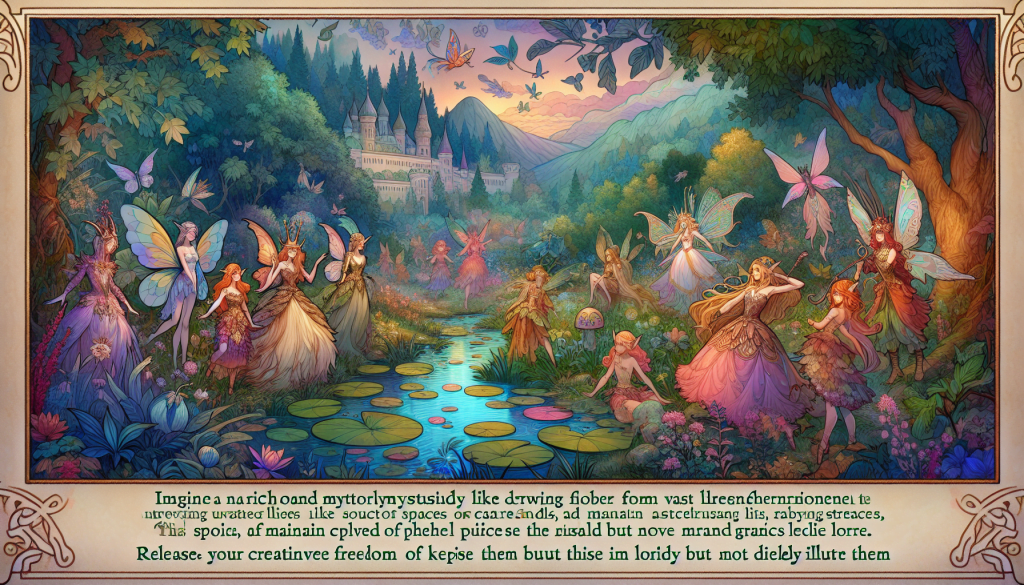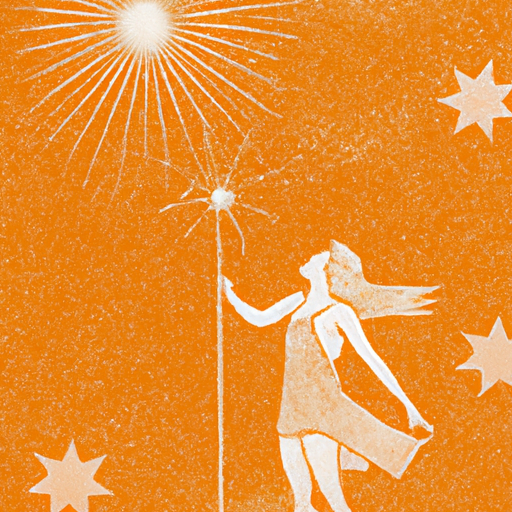Venturing into the rich tapestry of folklore and mythology, we find ourselves enchanted by the diverse array of fairy types. In our article, “Exploring Fairy Types in Mythology: A Journey Through Names”, we will embark on an enchanting odyssey, tracing the origins and significance of fairy names. From the ethereal to the eerie, these names reveal hints of each fairy’s unique nature and role within their mythological landscapes. Join us on this magical sojourn to understand the power of names in folklore and unravel the captivating tales behind them.

Understanding Fairies in Mythology
Fairies, featured widely in mythologies around the world, are fascinating creatures shrouded in a veil of mystery. These mythical beings have diverse interpretations across different cultures, but they share several common features, such as their association with nature, their supernatural powers, and their propensity for mischief.
Mythological Context of Fairies
In terms of mythological context, fairies are generally depicted as humanoid creatures with mystical abilities. They often inhabit the natural world, living in forests, streams, hills, and other outdoor areas. Traditionally, fairies are known for their inclination towards playfulness and mischief, although some can be benevolent or malevolent, depending on the cultural context.
Cultural Variations of Fairy Mythology
The interpretation of fairies varies significantly among different cultures. For instance, in some traditions, fairies are seen as powerful nature spirits, while in others, they’re depicted as little tricksters. In some cultures, they’re benign and helpful, while in others they are feared for their unpredictable behavior and potential to cause harm. The essence of fairy mythology proves to be a rich tapestry of stories, varying from culture to culture, yet fascinating in their unique ways.
Famous Western Fairy Names
Oberon and Titania: Fairy Royalty
Oberon and Titania, the king and queen of the fairies, are well-known characters from Shakespeare’s “A Midsummer Night’s Dream”. Oberon represents the majesty of the fairy world, while Titania embodies its beautiful, yet capricious nature. Their stories depict the power and allure of fairy kingdoms, captivating readers for centuries.
Puck: The Mischievous Sprite
Another famous western fairy is Puck, also from “A Midsummer Night’s Dream”. Known for his mischief and irreverence, Puck perfectly represents the playful and unpredictable aspect of fairy mythology. His ability to cause chaos and confusion but still remain likable is a testament to his enduring popularity in literature and theatre.
Tinkerbell: Modern Depiction
Tinkerbell, from J.M. Barrie’s “Peter Pan”, is a modern take on fairy mythology. Unlike traditional mythological fairies, Tinkerbell is a lovable, devoted character who uses her magical powers to help her friends. This reflects a shift in the portrayal of fairies from capricious tricksters to benevolent helpers, demonstrating the evolving interpretation of these creatures over time.
Fairy Types in Celtic Mythology
Sidhe: Nobility of Fairy Realm
In Celtic mythology, the Sidhe are considered the nobility of the fairy realm. Often associated with mounds or hills, these fairies are known for their regal nature and their love of music and festivity. The Sidhe are revered and respected, embodying the grandeur and majesty of the fairy world.
Leprechauns: Irish Fairies
Perhaps the most iconic Irish fairies, Leprechauns are small, solitary creatures known for their shoemaking and their hidden pots of gold. These characters represent a more earthbound and domestic aspect of fairy mythology, focusing on craft and cunning rather than grandeur or mysticism.
Banshee: The Wailing Fairy
The Banshee is a rather somber figure in Celtic mythology, often seen as an omen of death. Known for her mournful wailing, the Banshee is a stark reminder of the darker, more sorrowful side of the fairy world, highlighting the complex nature of these mythical beings.
Nordic Fairy Types and Names
Huldra: Seductive Forest Spirits
Huldra are seductive forest spirits from Nordic mythology. Often depicted as stunningly beautiful women, these fairies are known for luring unsuspecting men into the forest. Despite their alluring image, Huldra represent the danger and unpredictability of the fairy world.
Nisse: House Spirits
In contrast, Nisse are helpful house spirits, revered for their devotion to the family and home. These fairies embody the more congenial aspect of fairy mythology, symbolizing protection, family, and home.
Elves: Magical Beings
Elves in Nordic folklore are magical beings associated with beauty, elegance, and wisdom. They represent the enchanting and noble aspects of fairy mythology, further adding to the rich tapestry of mythical fairy characters.

Fairy Types in Slavic Mythology
Vila: Winged Elf-like Creatures
Vilas, from Slavic mythology, are known as winged elf-like creatures that live in the wilderness or in the clouds. Associated with wind, they are known for their healing and prophetic abilities. Vilas illustrate the magical and heavenly aspect of fairy mythology.
Rusalka: Water Spirit
Rusalka are water spirits from Slavic mythology, often considered the Slavic equivalent of mermaids. They personify the elemental aspect of fairy mythology, living in lakes and rivers and often associated with enchantment.
Domovoi: Household Spirit
The Domovoi, akin to the Nisse in Nordic folklore, are household spirits known for being protective of the family and home. These fairies represent the domestic element of fairy mythology in Slavic culture, emphasising care and protection.
Asian Fairy Lore
Yosei: Japanese Fairies
In Japanese mythology, Yosei, which translates to ‘fairy’, represent the spirit world’s influence on nature. Traditionally, they are associated with beauty and grace and are often linked with elements of nature such as flowers and trees. These fairies epitomise the connection between the fairy world and the natural world.
He Xian Gu: Chinese Immortal Fairy
In Chinese mythology, He Xian Gu is one of the Eight Immortals and the only female among them. Known for her wisdom and spiritual enlightenment, she is a symbol of the transcendental and enlightening aspect of fairy mythology in Asian cultures.
Peri: Persian Fairies
Peris, in Persian mythology, are considered to be spirits of fallen angels who seek redemption. Associated with beauty and benevolence, these fairies embody the redemption concept and the struggle between good and evil in Persian fairy mythology.
Fairy Types in African Mythology
Aziza: Beneficial Fairies
Aziza, in African mythology, particularly in the folklore of the Dahomey people of Benin, are beneficial fairies that provide hunters with good luck and insight. They represent the benevolent side of the fairy world and their positive influence on human affairs.
Mami Wata: Water Spirits
Mami Wata, meaning ‘Mother Water’, is a water deity often associated with mermaids or snakes in African mythology. These spirits illustrate the potent combination of fear and fascination that water bodies held for pre-modern societies and the deep-seated respect for the elemental forces embodied by these powerful spirits.
Abatwa: Tiny Peoples of the Wild
Abatwa, the tiny peoples of the wild, represent common folk tales in Zulu mythology, known for their tiny stature and their affinity with animals. These fairy beings embody the colloquial and earthy aspects of fairy mythology, illustrating the close relationship between humans, animals, and the fairy world.
Fairies in Aboriginal Mythology
Mimis: Earth Spirits
Mimis are earth spirits from Aboriginal mythology, believed to inhabit the rocky escarpments of northern Australia. Known for their slim, elongated bodies, they represent the hidden aspects of the natural world, reinforcing the belief that spirits inhabit every part of our natural environment.
Yara-ma-yha-who: Fierce Spirit
The Yara-ma-yha-who is a more fierce and scary spirit from Aboriginal lore. Often depicted as a small, red man with a large head and mouth, this creature both fascinates and scares, representing the more dangerous and frightening aspects of mythical fairies.
Wandjina: Weather Spirits
Wandjina are weather spirits from Aboriginal mythology, usually depicted with large eyes but no mouths, symbolizing their power to bring about torrential rain and thunderstorms. Wandjina emphasize Aboriginal people’s awe and reverence for nature’s power, personified in these formidable weather spirits.
Comparative Study of Different Fairy Types
Similarities in Fairy Types
Upon examining the various fairy types across cultures, we find apparent similarities. Irrespective of geographical boundaries and cultural differences, fairies are universally connected to nature, often embodying its beauty, power, and unpredictability, and almost always bearing some supernatural aspect or magical ability.
Contrasts in fairy mythology
However, the contrasts are equally intriguing. In some cultures, fairies are feared as potentially dangerous and mystical beings. In others, they are revered for their wisdom, beauty, and benevolence.
Evolving Interpretations
Furthermore, it’s worth noting how interpretations of fairies have evolved over time. Traditionally, they were often portrayed as capricious, unpredictable beings, feared for their tricks and potential to cause harm. Today, however, these creatures have taken on a more benevolent, often romanticized persona, particularly in contemporary popular culture.
Modern Influence of Fairy Mythology
Fairy Tales and Children’s Literature
The influence of fairy mythology on children’s literature is apparent, with countless beloved stories and characters stemming from these enchanting legends. From the lovable Tinkerbell in “Peter Pan” to the mischievous Puck in “A Midsummer Night’s Dream”, fairies serve as inspiring characters, teaching valuable lessons about love, bravery, and friendship.
Fairies in Film and Television
The influence of fairies extends beyond literature into film and television. These magical creatures have evolved in their depictions, now often presented as complex characters complete with their unique personalities, preferences, and storylines.
Influence on Modern Culture and Festivals
Fairies also profoundly influence modern culture and festivals. From the fairy tale-themed party decorations to the enchanting fairy-inspired costumes seen at carnivals and festivals worldwide, the appeal of these magical creatures extends far beyond books and screens. Their mythological roots continue to form a rich part of our cultural expression, reminding us of the enchantment and mystery inherent in our world.


